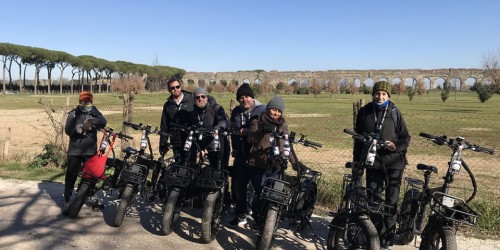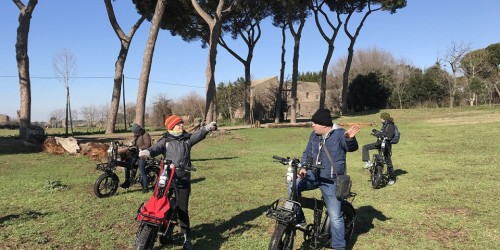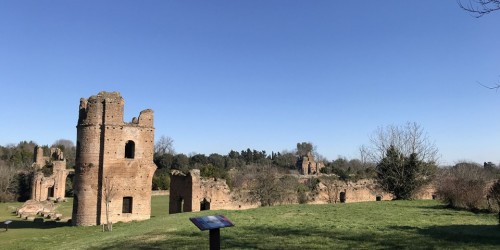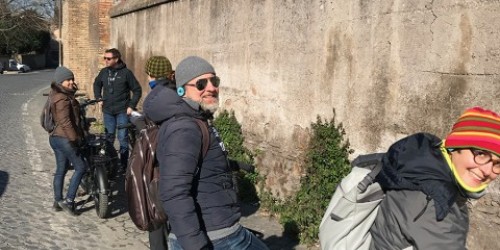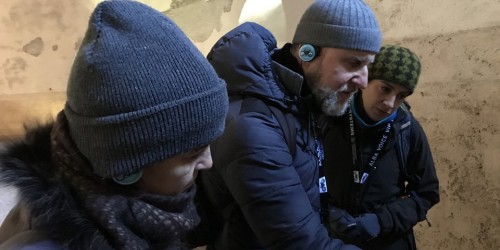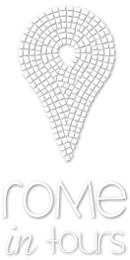
 Rome in Tours
Rome in Tours

Tours
Off the Beaten Path
The ultimate Appian way tour with electric bikes
Riding an electric bike over the "Queen of Roads"
- Panoramic
- Highlights
- Avoid the crowd
- Duration
- 4h
- Meeting Point
- View on Google Maps
- Meeting Point
- Via Cavour, 138 - next to Termini train station
- Meeting Time
- 8:30am
- Included
- bike rental, radios and earpieces
- Tips
- wear comfortable shoes and hat on summer
- Logistic
- bottles of water can be easily refilled at several drinking fountains
- Sites Visited
- Short ride from the meeting point to the beginning part of the Appian Way
- Aqueduct of Claudius
- Circus Maximus
- Bath of Caracalla
- Arch of Druso
- Porta San Sebastiano
- Church of "Domine quo vadis"
- Villa di "capo di bove"
- necropolis
- Park of the Aqueducts (a gem!! a doozy for my riders! off the beaten path on all the traditional bike tours)
What to expect
Hello bikers!! Passionate, expert, professional, occasional doesn't matter your skills on a bike we will test you! Safety first! We want you to be confident on an electric bike to save energies for a 19 miles ride! After a couple of minutes you realize how easy and natural and what kind of relief can be to have a support on a long ride that by the way will be almost exclusively on a flat path. It will be up to you then to choose the gear and so to estabilish along the tour how comfortable the riding can be without making any effort or otherwise ride without pedal assistence and have no regrets in front of a pizza after the tour!
Take a ride with us to discover the real DNA of the romans as architects and builders. The street, a so incredible masterpiece of engineering, was called by the romans “regina viarium”, queen of the streets. Built in 312 BC by Appius Claudius Caecus, a politician, the Appian way used to connect Rome with the south-eastern part of the empire through the harbor of Brundisium, nowadays Brindisi, southeast of Italy.
Try to image the impact for those coming from north Africa, Greece, Turkey and Crete whose first contact to the eternal city was through this exceptional work of technology as they approached the city shocked by the mighty roman walls and, once inside, the Circus Maximus, the Palatine hill and a monumental fountain on 3 levels, the Septizodium, made by the first african emperor Septimius Severus to impress his fellow citizens. It will be so evident to you, as it was for those coming from the provinces and subjected to the roman power, how the magnificence of the roman infrastructures was a clear instrument to send a precise message to the submitted, inculcating fear and awe even through the massive architectural enterprises.
With a length of 360 roman miles, most of them still with the original basalt blocks paving, the Appian way is the longest ancient roman street still preserved. It has been the location of important historical events like the crucifixion of Spartacus' 6000 soldiers in 71 BC along the first 120 miles of the Via, or, the capture of Rome, during WWII in May 1944, when the Allies coming from south through this street, forced the German forces to escape to the north of Florence and finally in 1960 summer olympics when it served as part of the men's marathon course.
So image yourselves in the shoes of an ancient roman citizen, virtually moving out of the city for an excursion along the Appian way. Think yourself completely surrounded by nature and archaeology in a park where you won't even hear the noise of the city traffic. Along the itinerary we won't miss the church of “Domine, quo vadis” whose name refers, according to the legend, to the phrase Peter said to Jesus, "Lord, where are you going?" and Jesus answered, "I am going to Rome to be crucified again", the Circus of Maxentius, location of the movie Ben Hur, catacombs, aqueducts, ancient roman villas and many other hidden gems!
Additional info and suggestions
It is mandatory to wear a mask to cover nose and mouth. The mask should be worn for the entire duration of the visit
